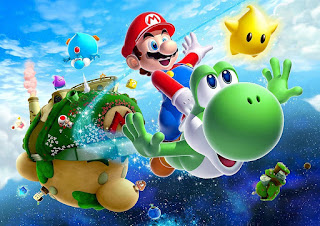Super Mario Galaxy 2's 10 year anniversary - What makes it special and how it surpassed its predecessor
Courtesy of Nintendo Life
What Made Super Mario Galaxy Special?
When Super Mario Galaxy released, it set a new precedent for Nintendo games. The space-themed adventure complimented the new gravity physics and round planets, an element unheard of for its time. While providing an interstellar platforming experience, it also brought forth the best of the tried-and-true Mario formula with its classic enemy designs, powerups, and level structure.
Among the most striking elements were the beautiful and glowing visuals, the space backgrounds, and the orchestrated soundtrack. Among Mario games, Super Mario Galaxy - and its sequel - may have the best soundtrack in the series. The game's overall polish and level diversity resonated well among fans. As a result, Super Mario Galaxy would go onto receive heavy critical acclaim and receive the honor of Game of the Year.
How did Super Mario Galaxy 2 set itself apart?
When Nintendo developed Super Mario Galaxy 2, they had many previously unused concepts in mind. For starters, one was adding Yoshi, Mario's best friend who aided him in Super Mario World and Super Mario Sunshine. Another method they used involved adding more layers of challenge to the game. While Super Mario Galaxy felt comparatively easy, the sequel would be more difficult for Mario vets while still appealing to a younger audience.
Amidst clever stage design choices, such as using the Wiimote controllers to "flip" stage elements with a flick, collecting more Stars and big coins unlocked the toughest world in the game. In Super Mario Galaxy, you could play as Luigi after getting 120 Stars. However, besides using his eability to make higher jumps and having slippery traction, it was otherwise no more than a cosmetic difference. Beating the game with all 240 Stars - 120 from Mario and Luigi each - meant seeing a fireworks celebration at the end.
Super Mario Galaxy 2 however, did not require you to play as Luigi to collect all 242 stars. While the game required you to revisit worlds and collect the arbitrarily placed Green Stars, you could unlock a final challenge world. You would also deposit 9,999 Star Coins into the game's Toad Bank. These stages were much tougher than the ones that came before.
Once you unlocked the final stage, you were set to clear Grandmaster Galaxy, an incredibly difficult stage. Also, by depositing 9,999 Star Bits into the Toad Bank, you unlocked a variation called The Perfect Run, which was one of the most satisfying, yet challenging stages in Nintendo history.
Legacy
Much like its predecessor, Super Mario Galaxy 2 would go onto win multiple accolades, including Game of the Year Awards. Super Mario Galaxy 2 continues to reign as one of the very best Mario games along with its predecessor. However, Galaxy 2 set itself apart by refining the challenge and keeping the game's creative design despite using the same engine. Super Mario Galaxy 2 would be followed by Super Mario 3D Land and Super Mario 3D World, the latter of which included Green Stars as well as a cosmic world featuring Galaxy's cosmic princess, Rosalina.
The tutorials feel cleverly placed and never forced. They show pictures of your controller actions in the backgrounds and never take up your time. Kirby games take a similar note as well. It's an example of how tutorials should be implemented in games, both well-paced and well-timed, but never force-fed to the player.
The Mario Galaxy stage would appear in Super Smash Bros. for Wii U. It would feature a number of tracks from both games as well as stage background elements, such as Starship Mario. Plus you had a gravity mechanic and the glowing aesthetic borrowed from both games. The stage later reappeared in Super Smash Bros. Ultimate.
Courtesy of Dystify Music
Mario games after Galaxy 2 would implement a "final challenge" stage. 3D Land, 3D World, and Odyssey all featured a postgame challenge where collecting enough of their respective goal treasures would unlock a daunting final level. 3D Land and 3D World also featured the Crown used in Grandmaster Galaxy.
Final Thoughts
I always preferred Super Mario Galaxy 2 to its predecessor. I found the original game incredibly fun, but admittedly easy and lacking the reward you would expect from earning all the collectibles. Not to say being easier is by any means bad, but Galaxy 2's challenge felt more satisfying. Both games offer between 20-30 hours of wonderfully polished gameplay. Galaxy even offers some lore snuck in by the game's director. Both have their perks, but Galaxy 2 won my heart over.
I feel it did a fantastic job of reusing the same engine while inputting dozens of creative levels. The 2D stages, for instance, hit the mark by capitalizing on the nostalgia value while also setting itself apart with gravity level elements. I greatly enjoyed using Rock Mario as well.
Super Mario Galaxy feels like the foundation for a fantastic Mario platformer. But Galaxy 2 set itself apart and went above and beyond as a Mario game, a platformer, and an iconic staple of Nintendo's very best design. With that said, happy 10 years to one of the highlight titles of Mario's beloved series! What fond memories do you have with Super Mario Galaxy 2? Let us know in the comments below.
*All images courtesy of Nintendo
*All images courtesy of Nintendo





Comments
Post a Comment